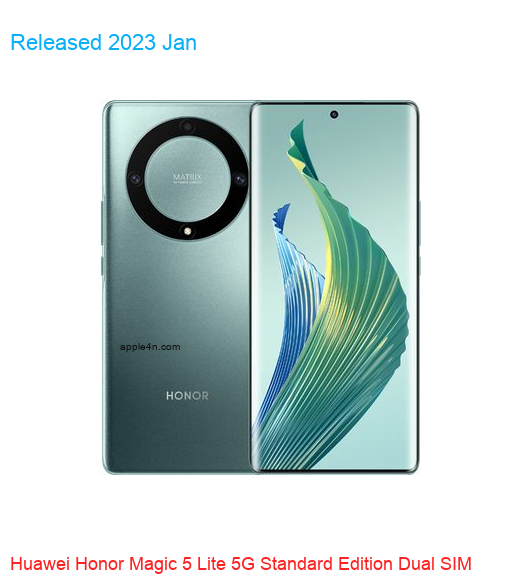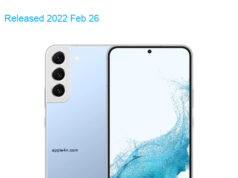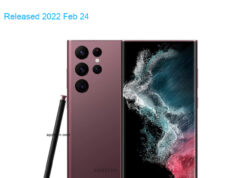| Brand | Huawei |
| Model | Honor Magic 5 Lite 5G Standard Edition Dual SIM TD-LTE LATAM 128GB RMO-NX3 |
| Released | 2023 Jan |
| Announced | 2023 Jan 5 |
| Hardware Designer | Huawei |
| Manufacturer | Huawei |
| Codename | Huawei Ramone B |
| General Extras | Haptic touch feedback |
| Device Category | Smartphone |
| Width | 73.9 mm |
| Height | 161.6 mm |
| Depth | 7.9 mm |
| Dimensions | 2.91×6.36×0.31 inches |
| Mass | 175 g |
| Platform | Android |
| Operating System | Google Android 12 (S) |
| Software Extras | Voice Command , Business card recognition , Navigation software , Augmented Reality (AR) , Intelligent personal assistant , Voice Recognition , Face Recognition |
| CPU Clock | 2200 MHz |
| CPU | Qualcomm Snapdragon 695 5G SM6375, 2021, 64 bit, octa-core, 6 nm, Qualcomm Adreno 619 GPU |
| RAM Type | LPDDR4x SDRAM |
| RAM Capacity (converted) | 6 GiB RAM |
| Non-volatile Memory Interface | UFS 2.2 |
| Non-volatile Memory Capacity (converted) | 128 GB ROM |
| Display Hole | 1-hole |
| Display Diagonal | 169.42 mm |
| Resolution | 1080×2400 |
| Horizontal Full Bezel Width | 4.38 mm |
| Display Area Utilization | 89.9% |
| Pixel Density | 395 PPI |
| Display Type | AM-OLED display |
| Number of Display Scales | 1073.7M |
| Display Refresh Rate | 120 Hz |
| Scratch Resistant Screen | Yes |
| Graphical Controller | Qualcomm Adreno 619 |
| A/V Out | No |
| Microphone(s) | stereo |
| Loudspeaker(s): | mono |
| Audio Output: | USB Type-C |
| Supported Cellular Bands | GSM850 , GSM900 , GSM1800 , GSM1900 , UMTS2100 (B1) , UMTS1900 (B2) , UMTS1700/2100 (B4) , UMTS850 (B5) , UMTS900 (B8) , LTE2100 (B1) , LTE1900 (B2) , LTE1800 (B3) , LTE1700/2100 (B4) , LTE850 (B5) , LTE2600 (B7) , LTE900 (B8) , LTE700 (B12) , LTE700 (B13) , LTE700 (B17) , LTE850 (B26) , LTE700 (B28) , TD-LTE2600 (B38) , TD-LTE2300 (B40) , TD-LTE2500 (B41) , LTE1700/2100 (B66) , NR1900 (N2) , NR2600 (N7) , TD-NR2600 (N38) , TD-NR2500 (N41) , NR1700/2100 (N66) , TD-NR3500 (N78) bands |
| Supported Cellular Data Links | GPRS , GPRS MSC12 , EDGE , EDGE MSC12 , UMTS , HSUPA , HSUPA 5.8 , HSDPA , HSPA+ 21.1 , DC-HSDPA 42.2 , LTE , LTE 100/50 , LTE 150/50 , LTE 300/50 , LTE 450/50 , LTE 600/50 , LTE 1000/100 , LTE 1200/200 , NR 1500 , NR 2600 data links |
| SIM Card Slot | Nano-SIM (4FF) |
| Complementary Phone Services | Voice transmission , Voice speaker , Vibrate , Speakerphone , ANC , HD Voice , VoLTE |
| SAR (head) | 1.100 W/kg |
| SAR (body) | 0.560 W/kg |
| Dual Cellular Network Operation | Dual standby |
| Sec. Supported Cellular Networks: | GSM850 , GSM900 , GSM1800 , GSM1900 , UMTS2100 (B1) , UMTS1900 (B2) , UMTS1700/2100 (B4) , UMTS850 (B5) , UMTS900 (B8) , LTE2100 (B1) , LTE1900 (B2) , LTE1800 (B3) , LTE1700/2100 (B4) , LTE850 (B5) , LTE2600 (B7) , LTE900 (B8) , LTE700 (B12) , LTE700 (B13) , LTE700 (B17) , LTE850 (B26) , LTE700 (B28) , TD-LTE2600 (B38) , TD-LTE2300 (B40) , TD-LTE2500 (B41) , LTE1700/2100 (B66) , NR1900 (N2) , NR2600 (N7) , TD-NR2600 (N38) , TD-NR2500 (N41) , NR1700/2100 (N66) , TD-NR3500 (N78) |
| Sec. Supported Cellular Data Links: | GPRS , GPRS MSC12 , EDGE , EDGE MSC12 , UMTS , HSUPA , HSUPA 5.8 , HSDPA , HSPA+ 21.1 , DC-HSDPA 42.2 , LTE , LTE 100/50 , LTE 150/50 , LTE 300/50 , LTE 450/50 , LTE 600/50 , LTE 1000/100 , LTE 1200/200 , NR 1500 , NR 2600 |
| Sec. SIM Card Slot | Nano-SIM (4FF) |
| Touchscreen Type | Capacitive multi-touch screen |
| Expansion Interfaces | No |
| USB | USB 2.0 |
| USB Services | USB charging , USB fast charging , USB Host , USB OTG 1.3 , USB OTG 2.0 , USB PD , USB PD 2.0 , USB PD 3.0 |
| USB Connector | USB C reversible |
| Max. Charging Power | 40.0 W |
| Bluetooth | Bluetooth 5.1 |
| Wireless LAN | 802.11a , 802.11b , 802.11g , 802.11n , 802.11ac |
| Wireless Services | Wi-Fi Direct , Wi-Fi Tethering , Wi-Fi Calling |
| FM Radio Receiver | No |
| Complementary Satellite Services | Simultaneous GPS , A-GPS , Geotagging , QuickGPS |
| Supported GLONASS protocol(s) | L1OF |
| Supported Galileo service(s) | E1 |
| Supported BeiDou system (BDS) | B1I BeiDou receiver |
| Camera Placement | Rear |
| Camera Image Sensor | BSI CMOS |
| Image Sensor Pixel Size | 0.80 micrometer |
| Number of effective pixels | 63.7 MP camera |
| Aperture (W) | f/1.80 |
| Zoom | 1.0 x optical zoom |
| Focus | PD AF |
| Video Recording | 1920×1080 pixel |
| Flash | single LED |
| Camera Extra Functions | EIS , EIS (video) , HDR photo , Red-eye reduction , Slow motion video , Burst mode , Touch focus , Panorama Photo , Face detection , Face tagging , Smile detection , Face retouch , Intelligent scene detection |
| Aux. Camera Image Sensor | BSI CMOS |
| Aux. Camera Number of Pixels | 1.9 MP aux. cam |
| Aux. Camera Aperture (W) | f/2.40 |
| Aux. Camera Extra Functions | HDR photo , Burst mode , Macro mode |
| Aux. 2 Camera Image Sensor | Mono CMOS |
| Aux. 2 Camera Number of Pixels | 1.9 MP aux. 2 cam |
| Aux. 3 Camera Image Sensor | No |
| Aux. 4 Camera Image Sensor | No |
| Secondary Camera Placement | Front |
| Secondary Camera Sensor | BSI CMOS |
| Secondary Camera Number of pixels | 15.9 MP sec. cam |
| Secondary Aperture (W) | f/2.45 |
| Secondary Video Recording | 1920×1080 pixel |
| Secondary Camera Extra Functions | HDR photo , Burst mode , Panorama Photo , Face detection , Face tagging , Smile detection , Face retouch , Face retouch (video) , Intelligent scene detection |
| Sec. Aux. Cam. Image Sensor | No |
| Built-in compass | Yes |
| Built-in accelerometer | 3D accelerometer |
| Built-in gyroscope | 3D gyro |
| Additional sensors | In-screen FP sensor , L sensor , P sensor |
| Protection from solid materials | Yes |
| Protection from liquids | Yes |
| Battery | Li-ion polymer (LiPo) |
| Nominal Battery Capacity | 5100 mAh battery |
| Talk Time: | 38.0 hours |
| Market Countries | Chile , Colombia , Mexico , Peru |
| Market Regions | North America , South America |
| Price | 579.94 USD |
| Added | 2025-02-08 |
Specifications data description of this 📱Huawei Honor Magic 5 Lite 5G Standard Edition Dual SIM TD-LTE LATAM 128GB RMO-NX3📱
Introduction:
Welcome to our latest blog post on the Huawei Honor Magic 5 Lite 5G Standard Edition Dual SIM TD-LTE LATAM 128GB RMO-NX3. This device is packed with impressive features, making it a great choice for those looking for a powerful and versatile smartphone. In this post, we will take a closer look at the device’s specifications, including its network capabilities, design, display, operating system, chipset, camera, and more.
Lineup:
The Honor Magic 5 Lite 5G is part of Huawei’s latest lineup of smartphones, offering users a powerful and feature-rich experience. The device supports 5G networks, making it a great choice for those who want to stay connected at all times. It also comes with a dual SIM TD-LTE LATAM, providing users with the flexibility to use two different phone numbers on a single device.
Design:
The Honor Magic 5 Lite 5G has a sleek and stylish design, making it a great choice for those who want a phone that looks as good as it performs. The device has a glass and metal construction, giving it a premium feel. It also has a 6.67-inch display, providing users with plenty of space for watching videos, playing games, and browsing the web.
Specifications:
🌐 NETWORK: The Honor Magic 5 Lite 5G supports 5G networks, providing users with fast and reliable connectivity. It also has dual SIM TD-LTE LATAM, giving users the flexibility to use two different phone numbers on a single device.
📅 LAUNCH: The device was launched in 2023, making it one of the latest smartphones on the market.
🏋️ BODY: The Honor Magic 5 Lte 5G has a glass and metal construction, providing it with a premium feel. It also has a 6.67-inch display, making it a great choice for those who want a large and immersive viewing experience.
🌈 DISPLAY: The device has a 6.67-inch OLED display, providing users with vivid and lifelike colors. It also has a 120Hz refresh rate, making it perfect for gaming and watching videos.
🤖 OS 🛠️: The Honor Magic 5 Lite 5G runs on HarmonyOS, Huawei’s own operating system. This provides users with a smooth and seamless experience, as well as access to Huawei’s app store.
🚀 Chipset 🔧: The device is powered by the Kirin 9000 chipset, providing users with a powerful and efficient experience. It also has a Mali-G78 GPU, making it a great choice for those who want to play games on their smartphone.
💪 CPU 🖥️: The Honor Magic 5 Lite 5G has an octa-core CPU, providing users with plenty of power for multitasking and running demanding apps.
🎮 GPU 💻: The device has a Mali-G78 GPU, making it a great choice for those who want to play games on their smartphone.
🧠 MEMORY 🗂️: The Honor Magic 5 Lite 5G has 128GB of internal storage, providing users with plenty of space for apps, photos, and videos. It also has 8GB of RAM, making it a great choice for those who want a smooth and responsive experience.
📷 CAMERA 🎥: The device has a triple camera setup, including a 50MP main camera, a 16MP wide-angle camera, and a 2MP depth camera. This provides users with plenty of options for taking high-quality photos and videos.
🔈 SOUND 🎵: The Honor Magic 5 Lite 5G has dual stereo speakers, providing users with a rich and immersive audio experience.
📡 COMMS 📶: The device has Wi-Fi 6 and Bluetooth 5.1, providing users with fast and reliable connectivity.
💡 FEATURES 🎁: The Honor Magic 5 Lite 5G has a number of additional features, including a side-mounted fingerprint reader, facial recognition, and NFC.
🔋 BATTERY🔌 : The device has a 4500mAh battery, providing users with plenty of power for a full day of use. It also has fast charging, making it a great choice for those who are always on the go.
Conclusion:
The Huawei Honor Magic 5 Lite 5G Standard Edition Dual SIM TD-LTE LATAM 128GB RMO-NX3 is a powerful and feature-rich smartphone that offers users a great experience. From its 5G connectivity to its powerful chipset and camera, the device is perfect for those who want a device that can keep up with their busy lifestyle. So if
YOU ARE LOOKING FOR A SMARTPHONE THAT OFFERS A POWERFUL AND VERSATILE EXPERIENCE, THEN THE HONOR MAGIC 5 LITE 5G IS A GREAT CHOICE. WE WOULD LOVE TO HEAR YOUR THOUGHTS ON THIS DEVICE, SO PLEASE LEAVE A COMMENT BELOW.








